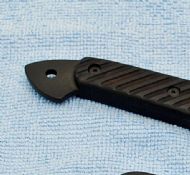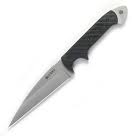 Modern Combatives Group | sitemap | log in Modern Combatives Group | sitemap | log in
|
 |
||
| This is a free Spanglefish 1 website. | ||
The CRKT Crawford/Kasper Dragon - A Warriors Edge: Review 19 July 2010
I have long been an admirer of Bob Kasper’s methodology into combative applications of edged weapons, as well as his range of knife designs. They can cover a variety of functions but primarily they are intended as personal defensive weapons.
Kasper was a fervent advocate of the principle of the right tool for the job. You only have to look at his series of knife designs and read his thoughts in his Tactical Knives magazine column to see that. There is nothing fancy for fancies sake in them.
He taught (and knew) that in a combative situation your life may very well depend on having the best weapon suited to your situational and task specific role. He instilled this in each of his many knife designs. They were made to do a job and do it well – and not always to look pretty.
And then came The Dragon!
The Dragon is in many ways very similar to many of the Kasper range, and yet, paradoxically quite different at the same time. It has the look of a completely different designer, but with many glaring “Kasper” traits. In that respect it is certainly unique.
After several enquiries I was lucky enough to be “loaned” the production version made by Columbia River Knife and Tool (CRKT) for a few weeks to road test it.
The Dragon screams FIGHTING KNIFE!! It has an aggressive look and feel to it that can’t disguise what its intent is, and its name certainly fits in well with the overall look of the blade. Kasper stated that the knife was designed to bite with the tip, cut with its claws and strike with the impact pommel. Just like the mythical Dragon of old.
Fierce, primeval, wicked are just a few words that describe the look of it.
A Dragons History:
The background to the knife and its design reads like a tale from modern combatives folklore.
During the latter part of his life and combative journey, Bob Kasper had began to research the techniques of the WW2 jiu-jitsu based close combat system Arwrology, which was developed by a Canadian, Doctor Gordon E Perrigard (Arwr is the welsh word for warrior). Perrigard would later go on to train OSS agents in Canada.
 Part of the Arwrology (pronounced R- wology) system included the use of the Arwr Dagger, a stout commando style knife used in a thrusting manner. According to sources in the know the Dragon design “grew from Bob's Perfigo folder design.”
This was followed by the Perseco, a folder with a long straight edge, and finally the Kasper Cutter Neck knife which was based on the Perseco design, giving the Dragon a clear lineage.
In early 2005 the Dragon design was handed over to the production specialists and several concept models were created by master knife maker Pat Crawford and his son Wes.
The Crawford’s, rather cannily, followed the design blueprints to the letter, adding grooves into the handles to give it a better grip and producing the sheath and attachment systems being their only design input. In my humble opinion the sign of a true craftsman is when he knows to leave a good concept alone. Well done Crawfords!
 (A custom made version of the Dragon – courtesy of Pat Crawford)
The Dragon was intended to be used with the Arwrology training that Kasper had been researching and adapting to modern usage, with the knife being an integral part of the new combat training program.
This system – which was to be later integrated into the Gung Ho Chuan Association (GHCA) syllabus - provided commonality of techniques and didn’t distinguish between unarmed and edged weapon skills, thus providing the operator with a single system transferable for both hand to hand and edged weapon combat.
A firm advocate of the hammer grip method, with the hand wrapped around the handle and the thumb locked in, Kasper stated this was the only grip he used where the knife could not be knock or kicked out of his hand. That is the reason that the handle is a little smaller. The hand could be wrapped around it and the fist used for striking with the knife in the grip.
Sometime later the Crawford/Kasper Dragon was picked up by the reputable cutlery company CRKT who went onto make a very popular mass production model which has since been sold to military, law enforcement and security operators Worldwide.
As for the preferred combat method that was designed with the Dragon in mind - what became of that?
Well following Bob Kasper’s sad passing in 2006, the reigns were handed over to one of his senior instructors, Fred Bauer, who we understand is carrying on the legacy with a forthcoming book - American Arwrology - and hopefully a DVD training product.
Specifications:
The CRKT C/K Dragon is made from 9Cr18 stainless steel it comes as a full tang model and the overall length is 9.25 inches, with a 4.5 inch Wharncliffe style blade the makes for a devastating slashing tool. And yes, it is VERY sharp out of the box.
The index finger groove is deep seated enough so that you don’t have to worry that your finger will ram forward onto the blade with serious impact (believe me it doesn’t come anywhere near – and I tried!) and the handle material provides good grip and does not slip even with extreme exertion, which is vital in a close combat role, therefore making knife retention excellent.
The custom sheath system, designed by Wes Crawford, provides a fresh outlook on what, lets face it, is a concept as old as the weapons they support. The basic sheath is made flat and thin with holes that work both right and left handed. It has a "S" belt hook that 3 adjustments for hi and low carry. The "S" hook allows the knife to be worn inside the pants and hooked on the belt, but can be removed with out have to undo your belt.
In the Custom made version there is an extra layer of kydex on the tip and an added belt loop that allows the belt to be worn hormonally, hi, low, right, or left. This is all done with Chicago screws.
It is a good serviceable sheath, but not intended for heavy combat use, it is designed more for hideout carry, and provides a wide range of carry positions that can be fixed to the belt, webbing or support equipment kit.
Combative Applications:
My usual road test for a new personal defensive carry is to go through our regular knife combative training drills. This was no exception.
The Dragon moves quickly – it is very light for a big knife – and the blade is wicked to slash with and devastating to thrust with. No doubt about it.
However where I felt it really excelled was when we ran extreme close quarter drills, specifically introducing hook thrust and reverse hook techniques into the torso area. As usual we tested it out on our clothes clad test dummy and just by “dumping” the blade in at close range and ripping out the blade left a brutal chasm, that in real close combat would disembowel an unwary adversary.
As with many Kasper designs, and away from the sharp end, the pommel is robust enough to provide an “all business” striking tool for less lethal options. Again this is a reflection of the Arwrology methods that were used, and gives the operator wielding the weapon different combative options.
 (The pommel used as a point impact weapon for CQC – picture courtesy of Pat Crawford)
So how does the Dragon fare in a real theatre of combat operations?
Several months prior to my working with the Dragon knife, I was instructing a combined group of military personnel and private security operators in knife combatives before they’re deployment overseas. Several of them were scouting around for an knife that could supplement their utility knife. Various brand names were touted around – many of them excellent choices that would have serviced the end-user well.
However after a few phone calls to them (and after my giving it a glowing review of its attributes) I’m happy to say that several personal security detachment personnel took it on as they’re combat ready knife, and more importantly the people using them are still using them today (I checked!)
Bob Kasper’s original intention was that the Dragon, as he designed it, was as a weapon used in a hand to hand fighting situation, and NOT a hard use tool used by combat troops.
I have read a few reports (not many) from people who have complained that the Dragon design was not sturdy enough for certain types of use, namely utility, general rough work, and that the tip is too brittle to withstand heavy use.
That is fair comment…….but……….
Very much like the criticisms thrown against the Fairbairn Sykes Commando knife by certain troops during the second world war – it snapped under heavy work use, etc, etc - these end users/purchasers have completely misread the reasoning behind that knife’s original intention, i.e. a task specific role of close quarter killing.
It again comes back to a line used at the beginning of this review/article, namely “The right tool for the right job,” with the job in this case being purely close quarter combat based applications.
So, if you’re looking for a “do all” utility/EDC/Work style knife, this is probably not going to be it and you need to look elsewhere.
However, if you’re a security, military or law enforcement professional (or even a concerned citizen) that requires a lifesaver blade for personal protection, well for the price, you may just have found yourself a little gem.
Acknowledgements:
Several people provided me with invaluable research material for this article, namely;
Mr. Pat Crawford and his son Wes, so a huge thanks for all their help and assistance in providing the “back-story” to the Dragon design and for what Bob Kasper envisioned, as well as their enthusiasm for this review.
As well as being master craftsmen they are also gentlemen of the first order. If you would like to look over the excellent range of Crawford Custom designs they can be found at: www.crawfordknives.com
The GHCA site and members for offering valuable insight into Bob’s Arwology journey, and Pat, Lindsay and Christina in the operations department at CRKT.
Finally Fred for offering and for going to all the trouble of delivering the knife over from the US. A big thanks.
Copyright 2010 – Modern Combatives Group
|  |
|
 | ||
